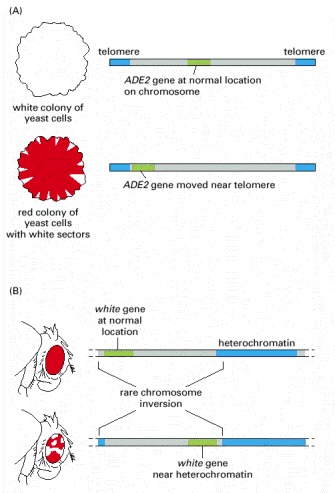From: The Global Structure of Chromosomes

NCBI Bookshelf. A service of the National Library of Medicine, National Institutes of Health.

(A) The yeast ADE2 gene at its normal chromosomal location is expressed in all cells. When moved near the end of a yeast chromosome, which is inferred to be folded into a form of heterochromatin, the gene is no longer expressed in most cells of the population. The ADE2 gene codes for one of the enzymes of adenine biosynthesis, and the absence of the ADE2 gene product leads to the accumulation of a red pigment. Therefore, a colony of cells that expresses ADE2 is white, and one composed of cells where the ADE2 gene is not expressed is red. The white sectors that fan out from the middle of the red colony grown on an agar surface represent the descendants of cells in which the ADE2 gene has spontaneously become active. These white sectors are thought to result from a heritable change to a less tightly packed state of chromatin near the ADE2 gene in these cells. Although yeast chromosomes are too small to be seen under the light microscope, the chromatin structure at the ends of yeast chromosomes is thought to have many of the same structural features as the heterochromatin in the chromosomes of larger organisms.
(B) Position effects can also be observed for the white gene in the fruit fly Drosophila. The white gene controls eye pigment production and is named after the mutation that first identified it. Wild-type flies with a normal white gene (white – ) have normal pigment production, which gives them red eyes, but if the white gene is mutated and inactivated, the mutant flies (white – ) make no pigment and have white eyes. In flies in which a normal white + gene has been moved near a region of heterochromatin, the eyes are mottled, with both red and white patches. The white patches represent cells in which the white + gene has been silenced by the effects of the heterochromatin. In contrast, the red patches represent cells that express the white + gene because the heterochromatin did not spread across this gene at the time, early in development, when the heterochromatin first formed. As in the yeast, the presence of large patches of red and white cells indicates that the state of transcriptional activity of the gene is inherited, once determined by its chromatin packaging in the early embryo.
From: The Global Structure of Chromosomes

NCBI Bookshelf. A service of the National Library of Medicine, National Institutes of Health.